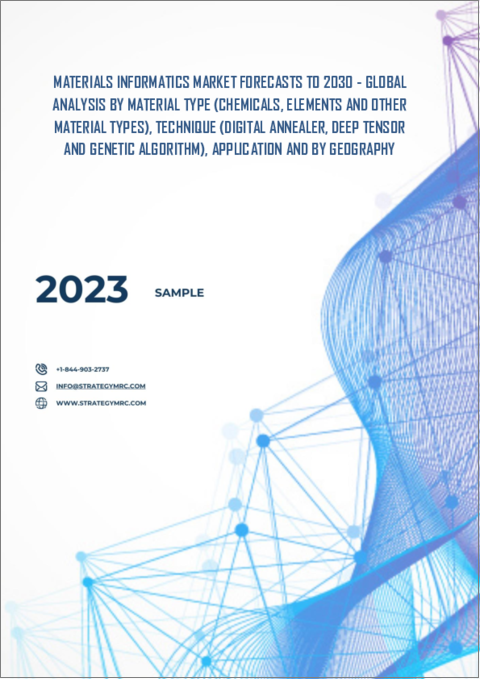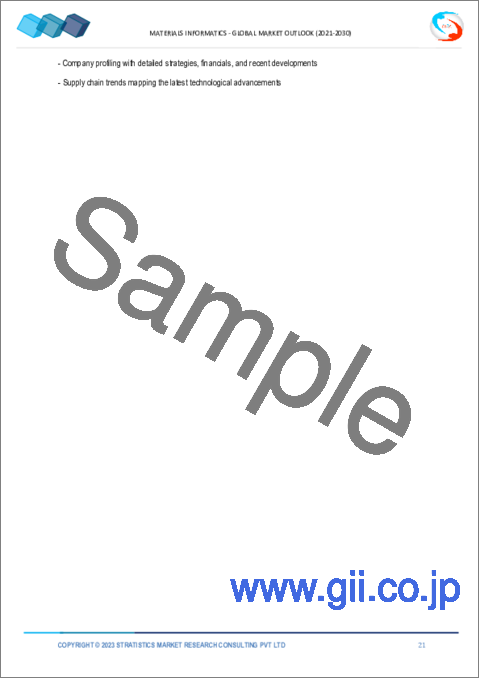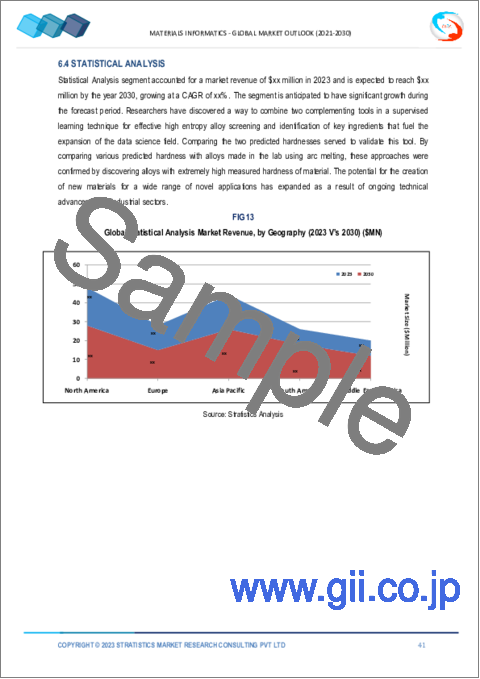|
|
市場調査レポート
商品コード
1339926
マテリアルズインフォマティクスの2030年までの市場予測:材料タイプ、技術、用途、地域別の世界分析Materials Informatics Market Forecasts to 2030 - Global Analysis By Material Type (Chemicals, Elements and Other Material Types), Technique (Digital Annealer, Deep Tensor and Genetic Algorithm), Application and By Geography |
||||||
カスタマイズ可能
|
|||||||
| マテリアルズインフォマティクスの2030年までの市場予測:材料タイプ、技術、用途、地域別の世界分析 |
|
出版日: 2023年08月01日
発行: Stratistics Market Research Consulting
ページ情報: 英文 175+ Pages
納期: 2~3営業日
|
- 全表示
- 概要
- 図表
- 目次
Stratistics MRCによると、世界のマテリアルズインフォマティクス市場は2023年に1億2,900万米ドルを占め、予測期間中のCAGRは18.3%で成長し、2030年には4億1,800万米ドルに達すると予測されています。
統計解析のようなインフォマティクス技術を活用することで、マテリアルズインフォマティクスは材料創製の有効性を高めることを目的としています。マテリアルズインフォマティクス」は、機械学習と、物性理論、実験、シミュレーション、データベース、クラウド・コンピューティング、セキュリティなど、さまざまな領域の技術を組み合わせたものです。両領域の技術の進歩により、マテリアルズインフォマティクスは情報科学と材料科学の合流点とも呼ばれ、その利用が増加しています。膨大な量のデータを高速に扱える環境が整ったことで、マテリアルズインフォマティクスの利用が促進されています。
機械学習とデータマイニングの利用の増加
材料科学の分野は、データマイニングによって革命を遂げ、エキサイティングな新しい展望が得られるようになっています。さらに、様々な形態の材料データに対する新しいデータマイニングのアイディアの継続的な改善と、材料特性データベースの普及が、材料設計に影響を与え続けると予想されます。さらに、マテリアルズインフォマティクス業界ではデータマイニングと機械学習技術の利用が拡大しているため、市場の拡大を新たな成功の高みへと押し上げると思われます。
ポリマー材料の使用における障害
金属、セラミックス、生体材料などの他の材料と比較した場合、ポリマー材料は、一貫性のあるデータベースの構築を困難にするマテリアルズインフォマティクスの分野特有の特徴を持っています。ポリマーの形態は多種多様であるため、これらのポリマー材料は非常に複雑であり、計算手法を使って名前を付けるのは困難です。ポリマーのカテゴリーには、共重合、ポリマー混合、直鎖ポリマーと分岐ポリマー、ポリマー混合なども含まれ、マテリアル・インフォマティクスに利用されるため、製品を作るプロセスに複雑さが加わり、市場の成長を阻害しています。
高エントロピー合金の開発とデータ分析
マテリアルズインフォマティクスの分野では、合金材料が飛躍的な拡大を遂げています。さらに、マテリアルズインフォマティクスは近年、材料および設計発見のための強力なツールとなっています。これは、材料科学と工学に関連する課題に取り組むためのデータサイエンス・アプリケーションに採用されています。このような最先端の技術的手法は、新たに発見された材料を見つけたり探したりするために、膨大な実験的制限空間を凝縮するために多くの場面で活用されており、その結果、市場の成長機会を幅広く生み出しています。
確立されたガイドラインやルールの欠如と、ごくわずかな技術資源
マテリアルズインフォマティクスを理解し、必要なアプリケーションにスムーズに統合するためには、必要なスキルを備えた専門家が不可欠です。この基本的な能力には、データを保存・収集するためのデータベースや、さまざまな種類と量のデータを処理するためのルールを理解するための算術や統計が含まれます。そのため、より精度の高いシステムの導入と統合が求められます。これは、潜在的なエンドユーザーがこれらのソリューションを広く採用する上で、大きな障害となっています。現在、化学・製薬、材料科学、製造など数多くの応用分野では、その有効性にかかわらず、ほとんどが従来の手法を踏襲し続けています。これは、市場の成長を妨げる包括的な計画がないためです。
COVID-19の影響:
2020年初頭にCOVID-19が普及したことで、材料科学や調査を含むいくつかの事業の機能と将来性が劇的に変化しました。COVID-19ウイルスが研究対象となった結果、他の産業にも影響が及びました。さらに、製造業における国の封鎖と停止は、多くの産業における研究に悪影響を及ぼし、材料情報学産業の拡大を再び遅らせています。
予測期間中、無機材料セグメントが最大になる見込み
無機材料セグメントは有利な成長を遂げると推定されるが、その主な理由は、エレクトロニクス、化学、食品、製紙、その他のセクターを含む多くの重要な事業が無機材料に大きく依存しているためです。一方、ハイブリッド材料は、環境に優しく、より産業適合性の高い有機およびハイブリッド製品への顧客志向の高まりにより、予想される期間を通じて驚異的な成長が見られます。
予測期間中、材料科学分野のCAGRが最も高くなると予想される
材料科学分野は、予測期間中に最も高いCAGR成長が見込まれます。新規材料の発見と開発、マテリアルズインフォマティクスアプローチは材料科学アプリケーションに応用できます。材料科学では、さまざまな材料やナノテクノロジーが使用されます。そのため、材料科学におけるコンピューティングの課題はより困難なものとなっています。また、このテーマでは、特定の望ましい機能性を持つ新規材料への開発が進んでいます。材料の作成、管理、最適化のプロセスを単純化するために、この分野では様々な材料、モデリングアプローチ、シミュレーションツール、物理学ベースや機械学習モデルが利用されています。
最大のシェアを占める地域:
北米は、材料科学と分析分野への投資の増加、エレクトロニクス、化学、その他多くの分野にわたる研究開発活動の活発化により、予測期間中最大の市場シェアを占めると予測され、2020年の世界のマテリアルズインフォマティクス市場における市場収益シェアの大半は北米が占めています。同地域はまた、技術的リーダーとしての地位を背景に、人工知能(AI)、機械学習(ML)、ビッグデータ、データ分析などの最先端技術の利用でも主導権を握っています。データサイエンス、機械学習、AIの統合は、市場の可能性に新たなパラダイムを生み出しました。
CAGRが最も高い地域:
アジア太平洋地域は、自動車、エレクトロニクス、建設などの業界全体で先端材料への需要を高めている同地域の力強い産業・経済拡大を含む多くの要因のため、予測期間を通じて最も高いCAGRを示すと予測されます。さらに、中国、インド、日本などの国々は、材料の科学技術を含む研究開発に多額の投資を行っています。アジア太平洋地域におけるマテリアルズインフォマティクスの拡大は、データサイエンスや材料科学の人材が豊富であることや、研究開発を支援する政府の施策も後押ししています。
無料のカスタマイズサービス:
本レポートをご購読のお客様には、以下のいずれかの無料カスタマイズオプションをご提供いたします:
- 企業プロファイル
- 追加市場プレイヤーの包括的プロファイリング(3社まで)
- 主要企業のSWOT分析(3社まで)
- 地域セグメンテーション
- 顧客の関心に応じた主要国の市場推計・予測・CAGR(注:フィージビリティチェックによる)
- 競合ベンチマーキング
- 製品ポートフォリオ、地理的プレゼンス、戦略的提携に基づく主要企業のベンチマーキング
目次
第1章 エグゼクティブサマリー
第2章 序文
- 抽象的な
- ステークホルダー
- 調査範囲
- 調査手法
- データマイニング
- データ分析
- データ検証
- 調査アプローチ
- 調査ソース
- 1次調査ソース
- 2次調査ソース
- 仮定
第3章 市場動向分析
- 促進要因
- 抑制要因
- 機会
- 脅威
- アプリケーション分析
- 新興市場
- 新型コロナウイルス感染症(COVID-19)の影響
第4章 ポーターのファイブフォース分析
- 供給企業の交渉力
- 買い手の交渉力
- 代替品の脅威
- 新規参入業者の脅威
- 競争企業間の敵対関係
第5章 世界のマテリアルズインフォマティクス市場:材料タイプ別
- 化学品
- エレメント
- ハイブリッド材料
- コポリマー
- コロイド
- 無機材料
- 金属
- 合金
- バッテリー
- その他の無機材料
- 有機材料
- ゴム
- ポリマー用添加剤
- その他の有機材料
- その他の材料タイプ
第6章 世界のマテリアルズインフォマティクス市場:技術別
- デジタルアニーラ
- ディープテンソル
- 統計分析
- 遺伝的アルゴリズム
第7章 世界のマテリアルズインフォマティクス市場:用途別
- 化学および医薬品
- 染料
- エネルギー
- 食品科学
- 製造業
- 材料科学
- 製紙用パルプ
- その他の用途
第8章 世界のマテリアルズインフォマティクス市場:地域別
- 北米
- 米国
- カナダ
- メキシコ
- 欧州
- ドイツ
- 英国
- イタリア
- フランス
- スペイン
- その他欧州
- アジア太平洋地域
- 日本
- 中国
- インド
- オーストラリア
- ニュージーランド
- 韓国
- その他アジア太平洋地域
- 南米
- アルゼンチン
- ブラジル
- チリ
- その他南米
- 中東とアフリカ
- サウジアラビア
- アラブ首長国連邦
- カタール
- 南アフリカ
- その他中東とアフリカ
第9章 主な発展
- 契約、パートナーシップ、コラボレーション、合弁事業
- 買収と合併
- 新製品の発売
- 事業拡大
- その他の主要戦略
第10章 会社概要
- Alpine Electronics Inc.
- Phaseshift Technologies
- Exabyte.io
- Schrodinger
- Materials Zone Ltd.
- Mat3ra
- BASF
- Citrine Informatics
- Nutonian Inc.
- Dassault Systemes
- Kebotix
- AI Materia
- Lumiant Corporation
- Sun Innovations
- Mitsubishi
- Fujitsu
- InSilixa
- MRL Materials Resources LLC
List of Tables
- Table 1 Global Materials Informatics Market Outlook, By Region (2021-2030) ($MN)
- Table 2 Global Materials Informatics Market Outlook, By Material Type (2021-2030) ($MN)
- Table 3 Global Materials Informatics Market Outlook, By Chemicals (2021-2030) ($MN)
- Table 4 Global Materials Informatics Market Outlook, By Elements (2021-2030) ($MN)
- Table 5 Global Materials Informatics Market Outlook, By Hybrid Materials (2021-2030) ($MN)
- Table 6 Global Materials Informatics Market Outlook, By Copolymers (2021-2030) ($MN)
- Table 7 Global Materials Informatics Market Outlook, By Colloids (2021-2030) ($MN)
- Table 8 Global Materials Informatics Market Outlook, By Inorganic Materials (2021-2030) ($MN)
- Table 9 Global Materials Informatics Market Outlook, By Metals (2021-2030) ($MN)
- Table 10 Global Materials Informatics Market Outlook, By Alloys (2021-2030) ($MN)
- Table 11 Global Materials Informatics Market Outlook, By Battery (2021-2030) ($MN)
- Table 12 Global Materials Informatics Market Outlook, By Other Inorganic Materials (2021-2030) ($MN)
- Table 13 Global Materials Informatics Market Outlook, By Organic Materials (2021-2030) ($MN)
- Table 14 Global Materials Informatics Market Outlook, By Rubber (2021-2030) ($MN)
- Table 15 Global Materials Informatics Market Outlook, By Additive Agent for Polymer (2021-2030) ($MN)
- Table 16 Global Materials Informatics Market Outlook, By Other Organic Materials (2021-2030) ($MN)
- Table 17 Global Materials Informatics Market Outlook, By Other Material Types (2021-2030) ($MN)
- Table 18 Global Materials Informatics Market Outlook, By Technique (2021-2030) ($MN)
- Table 19 Global Materials Informatics Market Outlook, By Digital Annealer (2021-2030) ($MN)
- Table 20 Global Materials Informatics Market Outlook, By Deep Tensor (2021-2030) ($MN)
- Table 21 Global Materials Informatics Market Outlook, By Statistical Analysis (2021-2030) ($MN)
- Table 22 Global Materials Informatics Market Outlook, By Genetic Algorithm (2021-2030) ($MN)
- Table 23 Global Materials Informatics Market Outlook, By Application (2021-2030) ($MN)
- Table 24 Global Materials Informatics Market Outlook, By Chemical & Pharmaceutical (2021-2030) ($MN)
- Table 25 Global Materials Informatics Market Outlook, By Dyes (2021-2030) ($MN)
- Table 26 Global Materials Informatics Market Outlook, By Energy (2021-2030) ($MN)
- Table 27 Global Materials Informatics Market Outlook, By Food Science (2021-2030) ($MN)
- Table 28 Global Materials Informatics Market Outlook, By Manufacturing (2021-2030) ($MN)
- Table 29 Global Materials Informatics Market Outlook, By Materials Science (2021-2030) ($MN)
- Table 30 Global Materials Informatics Market Outlook, By Paper & Pulp (2021-2030) ($MN)
- Table 31 Global Materials Informatics Market Outlook, By Other Applications (2021-2030) ($MN)
Note: Tables for North America, Europe, APAC, South America, and Middle East & Africa Regions are also represented in the same manner as above.
According to Stratistics MRC, the Global Materials Informatics Market is accounted for $129 million in 2023 and is expected to reach $418 million by 2030 growing at a CAGR of 18.3% during the forecast period. By utilizing informatics techniques like statistical analysis, materials informatics aims to increase the effectiveness of material creation. Materials Informatics" combines machine learning with technology from a variety of domains, including theory of properties, experiments, simulations, databases, cloud computing, security, etc. Due to the advancement of technology in both domains, materials informatics also known as the confluence of information science and materials science has seen an increase in its use. The environment has permitted the high-speed handling of enormous volumes of data, which has promoted the use of materials informatics.
Market Dynamics:
Driver:
Increasing use of machine learning and data mining
The field of material science has undergone a revolution because to data mining, and exciting new prospects are now available. Additionally, it is anticipated that continual improvements in new data mining ideas for various forms of material data and the proliferation of material property databases will continue to have an influence on material design. Moreover, due to the growing use of data mining and machine learning technologies in the material informatics industry would propel market expansion to new heights of success.
Restraint:
Obstacles in the usage of polymer materials
When compared to other materials like metals, ceramics, or biomaterials, polymer materials have a unique trait in the field of material informatics that makes the building of a coherent database difficult. Due to the large variety of polymer morphologies, these polymer materials are extremely complicated, making it challenging to name them using computational methods. The polymer category, which also covers copolymerization, polymer mixing, linear versus branched polymers, and polymer blending are utilized for material informatics, adding complexity to the process of creating a product which impedes the growth of the market
Opportunity:
The development of high entropy alloys, and data analysis
For the materials informatics sector, alloy material has experienced exponential expansion, the field of many primary elements or high entropy that permits alloy formation. Additionally, materials informatics has become a potent tool for material and design discovery in recent years. It is employed in data science applications to tackle challenges related to material science and engineering. These cutting-edge technical methods are utilized in a number of contexts to condense vast experimental restriction spaces in order to locate or look for newly discovered materials thus creating a wide range of opportunities for the growth of the market.
Threat:
Lack of established guidelines and rules along with very few technical resources
Experts with the requisite skill set are essential for comprehending and smoothly integrating material informatics into necessary applications. These fundamental abilities include databases for storing and gathering data as well as arithmetic and statistics to comprehend rules for processing various sorts and amounts of data. Therefore, the system must be installed and integrated with more accuracy. This is a significant obstacle to the wider adoption of these solutions by potential end users. Currently, numerous application fields such as chemical & pharmaceutical, materials science and manufacturing are mostly continuing to follow conventional techniques, regardless of the effectiveness of these. This is because there is no overarching plan in place which is hampering the market growth.
COVID-19 Impact:
The functioning and future potential of several businesses, including material science and research, have been drastically altered by the dissemination of COVID-19 at the beginning of the year 2020. Other industries were influenced as a result of the COVID-19 virus being the subject of study. Additionally, the country's lockdown and standstill in manufacturing have had a detrimental influence on research in a number of industries, which has once again slowed the expansion of the material informatics industry.
The inorganic materials segment is expected to be the largest during the forecast period
The inorganic materials segment is estimated to have a lucrative growth, due to this is mostly because to the substantial reliance on inorganic materials that many significant businesses, including those in the electronics, chemicals, food, paper, and other sectors, have. On the other hand, hybrid materials see phenomenal growth throughout the anticipated time frames due to rising customer inclination for organic and hybrid products that are environmentally benign and also more industry-compatible.
The materials science segment is expected to have the highest CAGR during the forecast period
The materials science segment is anticipated to witness the highest CAGR growth during the forecast period. The discovery and development of novel materials, material informatics approaches can be applied in materials science applications. A variety of materials and nanotechnology are used in materials science. This makes computing issues in materials science more challenging. This subject also sees ongoing development into novel materials with certain desired functionality. To make the processes of material creation, management, and optimization simpler, various materials, modelling approaches, simulation tools, and physics-based and machine-learning models are utilized in this sector.
Region with largest share:
North America is projected to hold the largest market share during the forecast period owing to rising investments in the field of material science and analysis as well as rising R&D activities across numerous sectors including electronics, chemicals, and many others, North America held the majority of market revenue share in the global material informatics market in 2020. The area also takes the lead in the use of cutting-edge technologies including artificial intelligence (AI), machine learning (ML), big data, and data analytics due to its status as a technological leader. Data science, machine learning, and AI integration have created a new paradigm for market possibilities.
Region with highest CAGR:
Asia Pacific is projected to have the highest CAGR over the forecast period, owing to number of factors, including the area's strong industrial and economic expansion, which has raised demand for advanced materials across industries including automotive, electronics, and construction, the Asia-Pacific region is anticipated to have the largest growth throughout the projection period. Furthermore, nations like China, India, and Japan have made significant investments in research and development, including the science and technology of materials. The expansion of material informatics in the Asia-Pacific area is also aided by the availability of a big talent pool in data science and materials science, as well as government measures to support research and development.
Key players in the market:
Some of the key players profiled in the Materials Informatics Market include: Alpine Electronics Inc., Phaseshift Technologies, Exabyte.io, Schrodinger, Materials Zone Ltd., Mat3ra, BASF, Citrine Informatics, Nutonian Inc., Dassault Systemes, Kebotix, AI Materia, Lumiant Corporation, Sun Innovations, Mitsubishi, Fujitsu, InSilixa and MRL Materials Resources LLC
Key Developments:
- In June 2023, ISAE Group and Dassault Systemes Partner to Accelerate the Digital Transformation of the Aerospace Industry, ISAE Group will deploy Dassault Systemes' 3DEXPERIENCE platform in its training programs for 7,000 students.
- In June 2023, Dassault Aviation and Dassault Systemes Partner to Bring Secure, Sovereign Collaboration on the Cloud to Next Generation Defense Programs, this next step in their long-term collaboration is a key driver of a European sovereign cloud that can influence other sectors such as health care and public services
- In January 2022, Schrodinger acquired XTAL BioStructures, Inc., a private company that provides structural biology services. The acquisition of XTAL BioStructures enabled Schrodinger to augment its ability to produce high-quality target structures.
Material Types Covered:
- Chemicals
- Elements
- Hybrid Materials
- Inorganic Materials
- Organic Materials
- Other Material Types
Techniques Covered:
- Digital Annealer
- Deep Tensor
- Statistical Analysis
- Genetic Algorithm
Applications Covered:
- Chemical & Pharmaceutical
- Dyes
- Energy
- Food Science
- Manufacturing
- Materials Science
- Paper & Pulp
- Other Applications
Regions Covered:
- North America
- US
- Canada
- Mexico
- Europe
- Germany
- UK
- Italy
- France
- Spain
- Rest of Europe
- Asia Pacific
- Japan
- China
- India
- Australia
- New Zealand
- South Korea
- Rest of Asia Pacific
- South America
- Argentina
- Brazil
- Chile
- Rest of South America
- Middle East & Africa
- Saudi Arabia
- UAE
- Qatar
- South Africa
- Rest of Middle East & Africa
What our report offers:
- Market share assessments for the regional and country-level segments
- Strategic recommendations for the new entrants
- Covers Market data for the years 2021, 2022, 2023, 2026, and 2030
- Market Trends (Drivers, Constraints, Opportunities, Threats, Challenges, Investment Opportunities, and recommendations)
- Strategic recommendations in key business segments based on the market estimations
- Competitive landscaping mapping the key common trends
- Company profiling with detailed strategies, financials, and recent developments
- Supply chain trends mapping the latest technological advancements
Free Customization Offerings:
All the customers of this report will be entitled to receive one of the following free customization options:
- Company Profiling
- Comprehensive profiling of additional market players (up to 3)
- SWOT Analysis of key players (up to 3)
- Regional Segmentation
- Market estimations, Forecasts and CAGR of any prominent country as per the client's interest (Note: Depends on feasibility check)
- Competitive Benchmarking
- Benchmarking of key players based on product portfolio, geographical presence, and strategic alliances
Table of Contents
1 Executive Summary
2 Preface
- 2.1 Abstract
- 2.2 Stake Holders
- 2.3 Research Scope
- 2.4 Research Methodology
- 2.4.1 Data Mining
- 2.4.2 Data Analysis
- 2.4.3 Data Validation
- 2.4.4 Research Approach
- 2.5 Research Sources
- 2.5.1 Primary Research Sources
- 2.5.2 Secondary Research Sources
- 2.5.3 Assumptions
3 Market Trend Analysis
- 3.1 Introduction
- 3.2 Drivers
- 3.3 Restraints
- 3.4 Opportunities
- 3.5 Threats
- 3.6 Application Analysis
- 3.7 Emerging Markets
- 3.8 Impact of Covid-19
4 Porters Five Force Analysis
- 4.1 Bargaining power of suppliers
- 4.2 Bargaining power of buyers
- 4.3 Threat of substitutes
- 4.4 Threat of new entrants
- 4.5 Competitive rivalry
5 Global Materials Informatics Market, By Material Type
- 5.1 Introduction
- 5.2 Chemicals
- 5.3 Elements
- 5.4 Hybrid Materials
- 5.4.1 Copolymers
- 5.4.2 Colloids
- 5.5 Inorganic Materials
- 5.5.1 Metals
- 5.5.2 Alloys
- 5.5.3 Battery
- 5.5.4 Other Inorganic Materials
- 5.6 Organic Materials
- 5.6.1 Rubber
- 5.6.2 Additive Agent for Polymer
- 5.6.3 Other Organic Materials
- 5.7 Other Material Types
6 Global Materials Informatics Market, By Technique
- 6.1 Introduction
- 6.2 Digital Annealer
- 6.3 Deep Tensor
- 6.4 Statistical Analysis
- 6.5 Genetic Algorithm
7 Global Materials Informatics Market, By Application
- 7.1 Introduction
- 7.2 Chemical & Pharmaceutical
- 7.3 Dyes
- 7.4 Energy
- 7.5 Food Science
- 7.6 Manufacturing
- 7.7 Materials Science
- 7.8 Paper & Pulp
- 7.9 Other Applications
8 Global Materials Informatics Market, By Geography
- 8.1 Introduction
- 8.2 North America
- 8.2.1 US
- 8.2.2 Canada
- 8.2.3 Mexico
- 8.3 Europe
- 8.3.1 Germany
- 8.3.2 UK
- 8.3.3 Italy
- 8.3.4 France
- 8.3.5 Spain
- 8.3.6 Rest of Europe
- 8.4 Asia Pacific
- 8.4.1 Japan
- 8.4.2 China
- 8.4.3 India
- 8.4.4 Australia
- 8.4.5 New Zealand
- 8.4.6 South Korea
- 8.4.7 Rest of Asia Pacific
- 8.5 South America
- 8.5.1 Argentina
- 8.5.2 Brazil
- 8.5.3 Chile
- 8.5.4 Rest of South America
- 8.6 Middle East & Africa
- 8.6.1 Saudi Arabia
- 8.6.2 UAE
- 8.6.3 Qatar
- 8.6.4 South Africa
- 8.6.5 Rest of Middle East & Africa
9 Key Developments
- 9.1 Agreements, Partnerships, Collaborations and Joint Ventures
- 9.2 Acquisitions & Mergers
- 9.3 New Product Launch
- 9.4 Expansions
- 9.5 Other Key Strategies
10 Company Profiling
- 10.1 Alpine Electronics Inc.
- 10.2 Phaseshift Technologies
- 10.3 Exabyte.io
- 10.4 Schrodinger
- 10.5 Materials Zone Ltd.
- 10.6 Mat3ra
- 10.7 BASF
- 10.8 Citrine Informatics
- 10.9 Nutonian Inc.
- 10.10 Dassault Systemes
- 10.11 Kebotix
- 10.12 AI Materia
- 10.13 Lumiant Corporation
- 10.14 Sun Innovations
- 10.15 Mitsubishi
- 10.16 Fujitsu
- 10.17 InSilixa
- 10.18 MRL Materials Resources LLC






